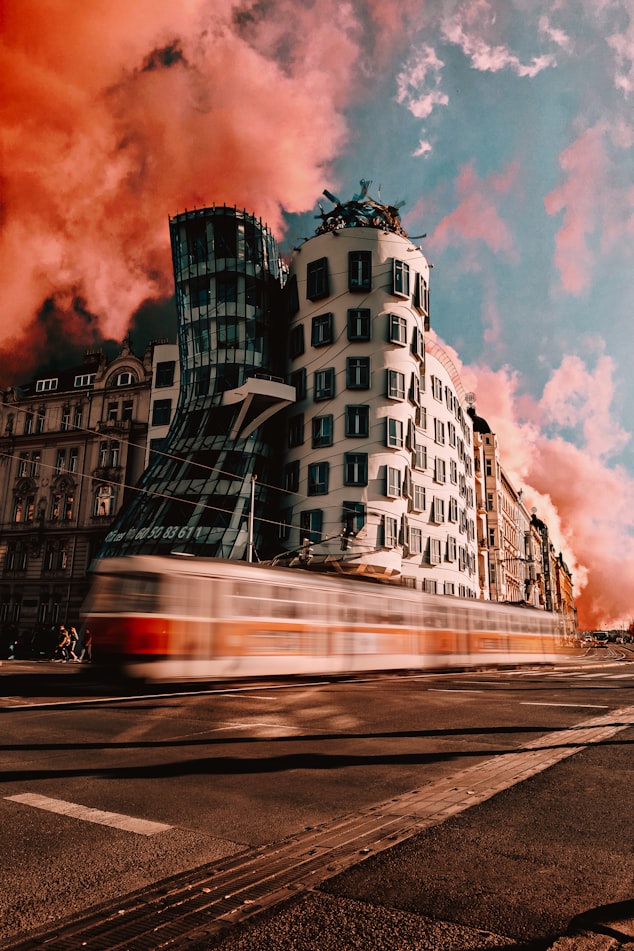The Dancing House is located in Prague, Czech Republic. It is one of the unique places in the world. The architects who designed the building are Vlado Milunić with Frank Gehry. Vlado Milunić was a Czech architect born on the 3rd of March, 1941. And Mr. Frank Gehry was a Canadian Architect Fred’s Full name is Frank Owen Gehry he was born on 28th of February, 1928. Dancing House has been one of the major works of both Vlado and Frank’s life. The Dancing House’s construction started in 1992 and it took 4 years to make the dancing house.
- ARCHITECT: FRANK GEHRY, VLADO MILUNIC
- YEAR: 1994-1996
- Structural Engineer : ATIPA, s.r.o.
- Developer: Nationale-Nederlanden Group
- Designed in: 1992
- Built-in: 1994-1996
- Floors: 8
- Land Area: 491m2
- Built-up Area: 5,400 m2
- Location: Prague, Czech Republic
Construction of The Dancing House:
As we read it took the time interval of 4 years to create the dancing house. And it is one of the most impressive buildings in the world. The design of the building is Deconstructivist architecture for the unusual shape it has. The shape has 99 concrete panels and each of the panels has a different shape and dimension. And at the top, we have a large twisted structure of metal named mary.

The second part of the house is the one that runs parallel to the river and is characterized by undulating moldings and unaligned windows. The architecture represents the famous dancers Fred Astaire and Ginger Rogers. The tower of rocks represents Fred The tower at the head made out of glass represents Ginger Rogers.
This building has such a confusing structure. The overall design was mainly aesthetic consideration such as the windows are the evidence that the building has two more floors. The windows have protruding frames, such as those of paintings and as the designer wanted to have the 3D design.
Spaces and Planning:
The Dancing House is a building made between the 18th and 19th centuries. And has two towers differentiated as a male and a female? Both of the towers are cylindrical in shape. The tower on the right is male and on the left, we have a female tower. The male tower expands while going upwards and the female tower is dramatically girdled from the waist.
There are shops, a hotel, and a small cafeteria, On the ground floor of the building, between the large circular pillars. This area for public interaction at ground level allows for the building to be much less isolated than traditional office developments. From the second to the seventh floor, the building is filled with offices. However, on the top level, there is a restaurant with panoramic views of the city, the Moldava river, and the nearby castle.


The Glass Tower:
Mr Ginger designed the Glass tower. The glass tower narrows the while going skywards and at a point it hangs onto the concrete tower. It has metaphorical legs and forms a skirt type structure and under that area, we have the entrance of the building.

The Concrete Volume:
Mr Fred Designed the Concrete Volume. This volume has three pillars and the windows of the building are not constructed as they are formed on a flat surface. And on the ground floor between the large pillars, there is a cafeteria, small shops, and a hotel.

Interior of The Dancing House:
A British architect Eva Jiřičná designed most of the interior of The Dancing House. The building has two floors underground and it is 9 floors tall. Every floor’s interior is different than the other. It is because of the asymmetrical structure of the outside. And due to the whole asymmetrical structure, the rooms aren’t symmetrical too. In the building, we have different- different floors for different purposes such as The commercial areas of the building are in the lobby and the first floor. The offices in the building are from floor two to floor six. The ninth floor housed a restaurant.
And because the building gets slim as it goes upwards the building is in two parts. The British architect of Czech origin, Eva Jiřičná Designed the interior part of The Dancing House.

Materials
The main materials of The Dancing House are steel, glass, and prefabricated concrete panels. Finished with plaster characteristic of the local architecture with a surface of 5842m², For the building corresponding to the river, they utilized concrete boards in 99 distinct shapes and measurements.
At the introduction, a model, Medusa, was put on top, made of metal cylinders and covered with stainless steel wire mesh. The architects, Gehry and Milunic, decided not to paint the exposed materials, but to display their natural colors: the glass is green the concrete grey, and the steel structure silver.

Discover more from archEstudy
Subscribe to get the latest posts sent to your email.


























